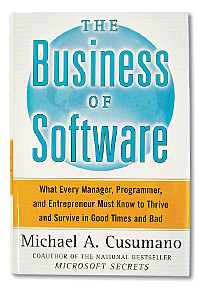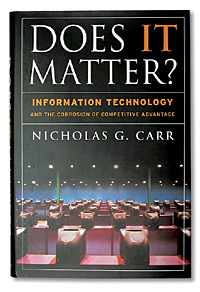Best Business Books 2004: IT & Innovation
The Sky is Still the Limit
The case for all the corporate investment and management interest in information technology over the last two decades really rests on one premise: IT is special.
That special nature derives, first, from the technology itself. Yes, information technology (IT) is an input to production for all kinds of goods and services, as they say in economics. But the stored-program computer is also a versatile, “universal” tool that is a source of productivity, innovation, and competitive advantage for companies, and a transforming agent of economic and cultural change for society as a whole.
Three recent books about IT share that assumption and sort through its implications in different ways, while a fourth gives an agnostic’s qualified dissenting view. Still, the authors of all four agree that now is a crucial time for rethinking the impact and application of information technology: The Internet bubble years are gone but hardly forgotten; IT spending is gobbling up about half of all business capital investment; new technologies are emerging apace; and the Internet’s impact on intellectual property law remains unsettled.
The Keystone Advantage: What the New Dynamics of Business Ecosystems Mean for Strategy, Innovation, and Sustainability, by Marco Iansiti and Roy Levien (Harvard Business School Press, 2004), presents the most original and compelling theme found in these new books. The “keystone” is a term drawn from biology that refers to a species (or corporation, in this case) that occupies the hub of a biological (or business) network and whose behavior improves the health of its ecosystem. Computing is no stranger to biological metaphors. The originators of object-oriented programming compared the behavior of their digital objects to cells in the 1970s. In business, academics and consultants have applied the notion of biological ecosystems to commerce for more than a decade. But Iansiti, a professor at the Harvard Business School, and Levien, a consultant, push the concept in provocative new directions in The Keystone Advantage.
The corporate keystones singled out by Iansiti and Levien include familiar corporate names like Microsoft, Wal-Mart, and eBay, but also some interesting, lesser-known companies. They provide an illuminating account of Li & Fung, a century-old Hong Kong–based trading company, for example, that is a vital hub in the apparel industry and that has relationships with more than 8,000 specialist firms in 40 countries. Using sophisticated IT tools, Li & Fung orchestrates a vast global supply chain to fit the needs of retailers like Gap and the Limited, guiding the production of firms employing more than a million people.
Organisms to Ecosystems
The spread of the Internet in the 1990s drastically reduced the cost of company-to-company communications, but only for a fairly limited kind of interaction, according to Iansiti and Levien. This is a crucial, if somewhat geeky, point in their analysis. Put simply, the first generation of Internet protocols, such as HTML, allowed for linking and viewing documents and Web sites. But the current generation of software protocols known collectively as Web services open the door to machine-to-machine, automated data exchange. In plain English, this would mean, for example, that one company’s manufacturing system can automatically reorder parts from a trusted supplier when a surge in demand indicates that parts are about to run low.
So the goal now within reach, the authors write, is “the creation of a truly interconnected ecosystem in which organizations are integrating both technology infrastructure and business processes.” Clever keystone companies like Li & Fung are moving quickly to adopt such Web services technology, while prodding and helping their business partners to do the same. The helping hand is the distinguishing characteristic of a keystone, for the keystone company succeeds or fails depending on the strength or weakness of its ecosystem. Competition, Iansiti and Levien argue, is thus being redefined. “The crucial battle,” they write, “is not between individual firms but between networks of firms. Innovations and operations have become a collective activity.”
Successful keystone companies share technology, tools, customer lists, market intelligence, and the value created within their network. They are greedy, but greedy for large long-term rewards. Microsoft, in the authors’ view, is the archetype, having pursued what they call “the most successful keystone strategy of all time.” The linchpin, they assert, is Microsoft’s long-term care and feeding of the 5 million software developers in 20,000 companies and IT departments worldwide who have written more than 70,000 applications to run on Windows, the immensely lucrative center of the Microsoft ecosystem.
Iansiti and Levien assert that there are three possible corporate strategies in the new business environment: keystone, dominator, and niche. The keystone advantage, to borrow the book’s title, is obvious. The niche strategy is to leverage the assets of an ecosystem and specialize. The authors cite niche winners such as Nvidia — a designer and marketer of graphics chips, which works with a keystone, Taiwan Semiconductor Manufacturing Company, to manufacture its chips — and Intuit, the maker of personal finance and tax software, which runs on Windows. The dominator strategy, the authors suggest, is usually shortsighted. Dominators try to hold on to too much themselves, tend not to share information and technology, and never foster a big ecosystem as a result. Apple is the classic dominator.
The biological analogy presented by Iansiti and Levien, like all analogies, has its limits, but their analysis of business ecosystems and strategy is both thoughtful and insightful — an important contribution to the IT literature. The most controversial aspect of the book is its policy prescriptions. According to Iansiti and Levien, keystones are all but paragons of virtue. It is a fallacy, the authors tell us, that keystone companies are chokepoints to innovation, or that they control their industries. The authors say they hope the ideas in their book will “spur a new look at antitrust economics.” It is essential for public welfare, they argue, that “the crucial roles played by these organizations be safeguarded and reinforced.”
Piracy and Property
The Keystone Advantage can, at times, read like an elaborate defense of Microsoft, which, you will recall, lost a landmark federal antitrust suit not so long ago. Reasonable people can disagree as to whether Microsoft’s conduct can be defended on economic grounds — a subject beyond the scope of this article. But it’s worth noting that one of the authors’ niche winners, Intuit, would have been taken out by Microsoft with a hostile bid had that takeover not been challenged by the U.S. Justice Department.
Lawrence Lessig, a professor at Stanford Law School, uses a different sort of biological analogy to reach a very different conclusion about competition in the IT-driven world of business. In Free Culture: How Big Media Uses Technology and the Law to Lock Down Culture and Control Creativity (Penguin Press, 2004), he sees the new “knowledge ecology” made possible by the Internet being gravely threatened by powerful corporate lobbyists responsible for a “subtle corruption of our political process.”
Lessig is well known as a forceful advocate for restraint in the application of intellectual property law to the Internet. In previous books, he has set forth his view of what is at stake as the law and new networked technology collide. In Free Culture, Lessig warns that things are going badly wrong, largely because a few industries, particularly Hollywood and the music business, have unduly influenced the enforcement of copyright law and the public debate.
The danger, Lessig says, is that in cyberspace we may lose much of society’s “creative commons” — a legally shielded zone of “fair use” that permits the sharing and copying of words, images, and music for personal, academic, and other mostly noncommercial uses. This did not happen, for the most part, with earlier technologies, from the printing press to the video recorder. Yet the law’s response so far, notably under the Digital Millennium Copyright Act of 1998, has “massively increased the effective regulation of creativity in America,” Lessig writes. The risk, he asserts, is that we become not the “free culture” of the book’s title but a “permission culture — a culture in which creators get to create only with the permission of the powerful, or of creators from the past.” He adds, “If we understood this change, I believe we would resist it.”
Free Culture is Lessig’s effort to explain the change as he understands it. Much of the book is a reconsideration of two words — piracy and property — as they apply to creative or intellectual property. Who could possibly endorse piracy, a form of theft, taking something that isn’t one’s own? That is certainly the way the record, movie, and software industries have portrayed the issue: as simple right and wrong, legal and illegal.
Yet, as Lessig explains in some wonderfully informative historical passages, new media technologies — film, records, radio, and cable television — have always brought with them unauthorized use, charges of theft, and a period of legal and corporate wrangling before new rules were established. Cable TV, for example, refused to pay the broadcast networks for retransmitting their copyrighted telecasts. Eventually, a fee was set that cable operators did have to pay the broadcasters, but a modest one determined by Congress so the broadcasters did not have power over the emerging technology of cable. “Every generation welcomes the pirates from the last,” Lessig writes. “Every generation — until now.”
The author casts his stance as a call for level-headed moderation against the extremism of the “copyright warriors.” Lessig quotes congressional testimony by Jack Valenti, the recently retired president of the Motion Picture Association of America, in which he says that all Hollywood is asking is that creative property owners be accorded the same rights as all other property owners. While this sounds reasonable, creative property rights have always been treated differently from physical property, notes Lessig. Traditionally, some unauthorized but legal copying has been protected in the interests of education, innovation, and creativity.
Lessig is a clear thinker and a fluid writer. But Free Culture is an advocate’s brief, and he sometimes stretches to try to make his points. He observes that all creative culture borrows from the past, noting that Disney borrowed from fairy tales and legends for its animated classics, from Snow White to Mulan. This “borrowing” he equates with the music-copying mantra, “Rip, mix, burn.” But a teenager pointing and clicking a computer mouse hardly compares to Snow White, the pioneering animated feature and Academy Award winner.
Lessig nevertheless makes a powerful case that the pendulum in intellectual property law has swung too far in favor of powerful rights-holding companies. He cites a string of legal decisions and corporate actions that do run contrary to common sense, including Fox’s demand that a documentary filmmaker pay $10,000 for a scene showing opera stagehands watching The Simpsons on TV for four seconds.
My own sense is that the pendulum in the intellectual property debate has by no means come to rest. Lessig suggests as much at the end of his book: “I’ve told a dark story. The truth is more mixed.”
 Darwin and Silicon Valley
Darwin and Silicon Valley
Both The Keystone Advantage and Free Culture point to technology as a force that opens the door to larger realms — an ecology of innovation and business ecosystems. Two other books focus more narrowly on the technology business and what appears to be its march toward maturity.
The Business of Software: What Every Manager, Programmer, and Entrepreneur Must Know to Thrive and Survive in Good Times and Bad, by Michael A. Cusumano (Free Press, 2004), has grim news for the software industry, declaring that there are probably “too many software companies in the world by a factor of three or more.” But Cusumano, a professor at the Massachusetts Institute of Technology’s Sloan School of Management, regards the Darwinian winnowing not as a sign of graying old age, but as a necessary step toward renewal.
The industry, perhaps more than any other, is a test bed for innovation and new business models largely because its essential ingredient — software — is a building material without material constraints. As one market opportunity fizzles, entrepreneurs quickly retool and chase another. In The Business of Software, Cusumano presents a fascinating litany of successes and failures, including those of startups he knows firsthand, like firstRain (whose distinguished backers include Stanford president John Hennessy).
Cusumano’s theme is that the $600 billion software industry is transitioning from a products orientation to a services orientation. Until the recent technology slump, he writes, “I believed — and I think most venture capitalists, managers, and entrepreneurs also believed — that it was better to be mainly a product company. I no longer think this is true.” The industry isn’t so much maturing as evolving, according to Cusumano, as more and more vendors offer their customers hybrid solutions of software and services. This has been IBM’s strategy for years; SAP has its version of the same formula; and even Microsoft, the classic software product company, has moved in that direction by adding in-house experts in everything from banking to health care and forging close partnerships with services suppliers like Accenture.
The Microsoft ecosystem, as Iansiti and Levien would put it, embraces services these days. The value in software is moving up the food chain of business, closer to partners, suppliers, and customers, and farther away from the innards of computing.
 A Defensive Weapon
A Defensive Weapon
Does IT Matter? Information Technology and the Corrosion of Competitive Advantage, by Nicholas G. Carr (Harvard Business School Press, 2004), is the most skeptical of the books reviewed. Carr, a former editor of the Harvard Business Review and now a consultant, author, and columnist for this journal, argues that IT is going the way of the industrial technologies of the 19th century — think of the railroads and the telegraph — to become an ordinary factor of production. “From a strategic standpoint they began to become invisible; they mattered less and less to the competitive fortunes of individual companies,” Carr writes. “Information technology is heading down the same path.” This is the seemingly subversive thesis of Does IT Matter?
The book is a longer treatment of a Harvard Business Review article, published in May 2003, that touched off a fierce debate, especially among those who read little more than its inflammatory headline, “IT Doesn’t Matter.” Of course IT matters, Carr writes, just not in the way many businesses assume. Yes, he agrees, technology lifts productivity and reduces costs. But Carr asserts that as IT matures, spreads, and becomes more standardized, the strategic value any individual firm can gain from technology diminishes. His strategic advice, then, is to keep a tight grip on the IT budget and “innovate when risks are low.”
In Does IT Matter? Carr is not the counterrevolutionary that the tabloid headline on the HBR article suggested. He says that IT is more a defensive weapon than an offensive one for most companies, but still a vital one. “Indeed,” Carr writes, “as the strategic value of the technology fades, the skill with which it is used on a day-to-day basis may well become even more important to a company’s success.”
The authors of all four of these books, including Carr, suggest that the importance of information technology as a stand-alone thing, the raw bits and bytes, is receding. Yet that is because it is becoming a more integrated part of business and society with the potential for great benefit or mischief, not less important or necessarily a commodity.
The future of information technology and its impact on our world depends on whether it is more like an industrial technology, as Carr suggests, or more like biology. Cusumano, for example, may be skeptical about the fate of many of today’s software companies, but he betrays no doubts about the technology. Software applications, he writes, are “limited mainly by human imagination. Since human creativity is so vast in potential and computer hardware is still evolving by leaps and bounds, it would be foolish to think of software technology as being mature.”
The optimistic “biological” view of IT may ultimately turn out to be wrong. But on the basis of the evidence in these books, it seems to have more power than the “industrial technology” view for explaining the past and present, and more promise for envisioning the future.![]()
Author profile:
Steve Lohr (lohr@nytimes.com), who covers technology for the New York Times, is the author of a history of computer programming, Go To: The Story of the Math Majors, Bridge Players, Engineers, Chess Wizards, Maverick Scientists and Iconoclasts — The Programmers Who Created the Software Revolution (Basic Books, 2001).


